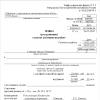7. Own financial resources of the enterprise. Composition and conditions of formation.
It is necessary to single out the concept of "capital" - a part of the financial resources invested in production and generating income at the end of the turnover.
Major share in own financial resources is the profit remaining at the disposal of the organization (enterprise) and distributed by the decision of the governing bodies. Depending on the financial policy of the organization (enterprise), the profit remaining at its disposal can be used as follows:
Aimed at full consumption;
Fully invested in other projects not related to the activities of the organization;
Reinvested in the development of the organization in full;
Distributed in the first three directions.
The second most important source of own financial resources serve depreciation deductions - monetary expression of the cost of depreciation of fixed production assets and intangible assets. They are of a dual nature, as they are included in the cost of production and then, as part of the proceeds from the sale of products, they go to the settlement account of the enterprise, becoming an internal source of financing for both simple and expanded reproduction. Accumulated depreciation charges form a depreciation fund intended for the reproduction of depreciated fixed assets.
Not all profit remains at the disposal of the organization (enterprise), part of it in the form of taxes and other obligatory payments goes to the budget system. The profit remaining at the disposal of the organization (enterprise) is distributed by the decision of the governing bodies for the purpose of accumulation and consumption and reserves. The profit allocated for accumulation is used for the development of production and contributes to the growth of the property of the enterprise. Profit directed to consumption is used to solve social problems.
8. External sources of financial resources.
Financial resources of the organization (enterprise) - this is a set of own cash income in cash and non-cash form and receipts from outside (attracted and borrowed), accumulated by the organization (enterprise) and intended to fulfill financial obligations, finance current costs and costs associated with the development of production.
According to the sources of education, financial resources are divided into own (internal) and attracted on different terms (external), mobilized for financial market and arriving in the order of redistribution.
attracted, or external, sources the formation of financial resources can be divided into own, borrowed, received in the order of redistribution and budget allocations. This division is due to the form of capital investment. In the capital market, there are two options for raising Money: equity and debt financing. With equity financing, the issue and placement of its shares on the stock market is carried out. The second option involves the issuance and placement of bonds (term securities), i.e. provision of capital on the basis of a bonded loan. If external investors invest money as entrepreneurial capital, then the result of such an investment is the formation of attracted own financial resources.
Entrepreneurial capital represents the capital invested in the authorized capital of another organization (enterprise) in order to derive profit or participate in the management of the organization (enterprise).
Loan capital is transferred to an organization (enterprise) for temporary use on the terms of payment and repayment in the form of bank loans issued for different periods, funds of other organizations (enterprises) in the form of promissory notes, bonded loans.
Funds raised in the financial market include funds from the sale of own shares and bonds, as well as other types of securities.
To the funds coming in order redistribution, include insurance compensation for emerging risks, financial resources coming from concerns, associations, parent companies, dividends and interest on securities of other issuers, budget subsidies.
Budget appropriations can be used both on an irrevocable and returnable basis. As a rule, they are allocated to finance government orders, individual investment programs, or as short-term state support for organizations (enterprises) whose products are of national importance.
Financial resources are used by the organization (enterprise) in the process of production and investment activities. They are in constant motion and remain in cash only in the form of cash balances on a current account in a commercial bank and in the cash desk of an organization (enterprise).
With a lack of own financial resources, the enterprise can use borrowed and attracted financial resources.
Borrowed sources of financial resources include:
a) loans from financial institutions;
b) budget loans;
c) commercial loans;
d) accounts payable, constantly in circulation and others.
The attracted sources of financial resources include:
1) funds of equity participation in current and investment activities;
2) funds from the issue of securities;
3) share and other contributions of members of the labor collective, legal entities and individuals;
4) insurance compensation;
5) receipt of payments for franchising, rent, selenge.
Borrowed funds include loans from commercial banks and other credit organizations, other loans. Raised financial resources include funds raised by issuing shares, budget appropriations and extra-budgetary funds, as well as funds from other enterprises and organizations raised for equity participation and other purposes.
All obligations of the enterprise are formed at the expense of borrowed funds: internal (internal accounts payable, deferred tax payments, etc.), and external (bank and commercial loans, bond issue own loan, financial leasing). Depending on the urgency of repayment, they are usually divided into long-term and short-term liabilities.
According to the duration of use, the capital of the enterprise is divided into fixed and variable.
Permanent capital is formed at the expense of the company's own capital and its long-term borrowed funds.
One of the central questions financial management is the management of the price of capital, which is based on the assessment of the need for resources and the analysis of the price of individual financial resources, which are determined by the self-interest of the enterprise and the laws of supply and demand in the capital markets.
When considering the issue of the price of capital, the sources of its formation are usually divided into internal and external.
Internal - created in the course of the activity of the enterprise, the payment for the use of which may be the lost average market income on retained earnings, on reserve and insurance capital, etc.
External - resources are acquired in the financial markets and have their own conditions for attracting, term and price. The price of external resources can be: interest paid for the use of bank loans; fines and penalties on commercial loans; interest on issued bonds; discount on bills; dividend paid to shareholders.
The total amount of funds that must be paid for the use of a certain amount of financial resources, expressed as a percentage of this volume, is called the price of capital.
The concept of the price of capital is one of the basic in the theory of enterprise management. It does not come down only to calculating the interest that must be paid to the owners of financial resources, but also characterizes the return on invested capital that the company needs to ensure in order not to reduce its market value.
To cover the needs for fixed and working capital, in some cases, it becomes necessary for an enterprise to attract borrowed capital. Such a need may arise as a result of deviations in the normal circulation of funds for reasons beyond the control of the enterprise:
Optional partners, extraordinary circumstances, etc.;
During the reconstruction and technical re-equipment of production;
Due to the lack of sufficient start-up capital;
For other reasons.
Borrowed capital for the period of use is divided into long-term and short-term. Long-term liabilities include capital with a term of more than one year, up to one year are classified as short-term liabilities. Elements of fixed capital, as well as the most stable part working capital(safety stock, part of accounts receivable) should be financed from long-term capital. The rest current assets, the value of which depends on the commodity flow, is financed by short-term capital.
The main forms of long-term liabilities are long-term loans banks and long-term borrowed funds(debt on a tax credit; debt on issued bonds; debt on financial assistance provided on a repayable basis, etc.), the maturity of which has not yet come or repaid within the stipulated period.
Short-term financial liabilities include short-term bank loans and borrowed funds, various forms of accounts payable of an enterprise (for goods, works and services; for promissory notes issued; for advances received; for settlements with the budget and extra-budgetary funds; for wages; subsidiaries; with other creditors) and other short-term liabilities.
Borrowed capital is characterized by the following positive features:
1. Sufficiently wide opportunities for attraction, especially with high credit rating enterprise, the presence of a pledge or guarantee of the guarantor;
2. Ensuring the growth of the financial potential of the enterprise, if necessary, a significant expansion of its assets and an increase in the growth rate of its volume economic activity;
3. Lower cost than own capital by providing the effect of a "tax shield" (withdrawal of the costs of its maintenance from the taxable base when paying income tax);
4. The ability to generate an increase in financial profitability (return on equity ratio).
At the same time, the use of borrowed capital has the following disadvantages:
1. The use of this capital generates the most dangerous financial risks in the business activities of the enterprise. The level of these risks increases in proportion to the growth specific gravity use of borrowed capital;
2. Assets formed from borrowed capital generate a lower rate of return, which is reduced by the amount of loan interest paid in all its forms;
3. High dependence of the cost of borrowed capital on fluctuations in the financial market. In a number of cases, with a decrease in the average loan interest rate in the market, the use of previously received loans (especially on a long-term basis) becomes unprofitable for an enterprise due to the availability of cheaper alternative sources of credit resources;
4. The complexity of the attraction procedure, since the provision of credit funds depends on the decision of other economic entities, in some cases requires appropriate third-party guarantees or collateral.
Borrowed resources are not the property of this enterprise and their use is fraught with loss of independence for it. Borrowed funds are provided on the terms of urgency, payment, repayment, which ultimately leads to their faster, compared with own resources, turnover. Borrowed funds include various types of loans attracted from other links credit system(banks, investment institutions, the state, enterprises, households).
Attracted resources - funds that do not belong to the enterprise, but are temporarily in its circulation. These funds before the emergence of sanctions (fines or other obligations to the owners) can be used at the discretion of the business entity. These are, first of all, sustainable liabilities - arrears in wages to employees, debts to the budget and off-budget funds, creditors' funds received in the form of prepayment, etc.
The ratio between these elements of financial resources determines financial stability business entity.
The next sign of the allocation of elements of financial resources is the urgency of use. As a rule, resources are classified into: short-term; medium-term; long-term.
Short-term resources - their validity period is up to a year. Designed to finance the current activities of the enterprise: the formation working capital, short-term financial investments, settlements with debtors.
Medium-term resources - from a year to 3 years - are used to replace individual elements of fixed assets, their reconstruction and re-equipment. In this case, as a rule, the goal is not to change technology or completely replace equipment.
Long-term resources are attracted, as a rule, for a period of 3 to 5 years and are used to finance fixed assets, long-term financial investments, and risky financing. In our opinion, the minimum time limit (3-5 years) of these funds is determined by the life of the fixed assets. This is how long, on average, machines and equipment are operated in economically developed countries. Over this period, their use is fraught with an overestimation of the cost of manufactured products (due to moral and physical wear and tear). Since the lower time limit for the use of these resources is determined by the functioning of machinery and equipment, it is logical to single out one more group of resources here - to finance facilities in excess of a long-term purpose, i.e. buildings, structures. The time limit can be 10-15 or more years. It is for such periods that it is possible to obtain a mortgage loan.
External financial resources- this is a kind of enterprise resources, which is expressed in the form of attracted and borrowed capital.
The concept of financial resources of the enterprise
Entrepreneurial activity involves the management of finances, cash, through their contributions and expenses, in order to make a profit in the future. Accordingly, for this, a business entity needs to have capital, which can be formed due to invested resources of various origins.
The company's own budget is formed, first of all, thanks to the contributions of the participants. In the future, if the legal entity activity will be successful, the source of formation internal resources there will be income from such activities. Net profit is calculated from the amount of income and expenses, which include the costs of doing business and paying the necessary payments (taxes, credit obligations, etc.). In addition, the operating budget of the enterprise is expressed in depreciation charges.
External financial resources of the enterprise
Despite the fact that own funds can, to a certain extent, ensure the activities of an enterprise, it is impossible to imagine in modern conditions a business not supported by third-party resources and contributions. External sources formation of financial resources include borrowed and borrowed funds. They form entrepreneurial and loan capital, respectively.
The first is expressed in the investment of the enterprise by third parties, legal or natural. Sometimes, entities with sufficient resources prefer funding already existing business instead of creating your own. In addition, investment in a particular enterprise may be carried out for the purpose of repurchasing shares and obtaining management rights.
Loan capital is transferred to a business entity only for a time, while the financial organization has its own benefit, expressed in the form of interest payments.
The ratio of entrepreneurial and loan capital
It is worth saying that in the current economic situation, the sources of formation of these types of capital may overlap. That is, the financial resources involved in the activities of the enterprise often themselves consist of credit funds. This is not always good, because the circulation of such resources is difficult, since banks and others financial institutions prefer to exercise tighter control over the funds issued on loans.
Essence of attracted capital
Note that entrepreneurial capital forms both internal and external sources of financial resources of the enterprise. Partially, these funds are used to create the necessary material funds that ensure the activities of business entities. The other part of them is the authorized capital, which is formed by selling the company's shares. In fact, it is the attracted capital that is a help for the financial operations of the enterprise.
The essence of loan capital
These resources can be considered as a means of operational regulation of economic activity. Since the company receives borrowed money only for a short period, this determines their liquidity and turnover rate. Loan capital can be formed with the help of credit loans from banks and non-bank entities, and by selling the company's bonds.
External financial resources
In addition to domestic financial resources mobilized in the course of economic activity, commercial enterprises accumulate them from outside. External resources combine a variety of receipts through the channels of the financial market, including the resources of non-residents, budgetary and non-budgetary sources, gratuitous receipts and other resources.
Financial Market Resources
The financial market allows organizations and enterprises to use its resources, if necessary, to mobilize large sums, as a rule, to finance large investment projects, business expansion, restructuring and other needs. Enterprises turn to the market, as a rule, with a lack of internal financial resources. For example, retained earnings and depreciation can be used to finance investments, but for major projects even the profit accumulated over several years is not enough.
An organization can accumulate resources in the market in two ways. The first involves borrowing by issuing own debt obligations (bonds) or by obtaining bank loans in the market loan capital. Such a path is called debt financing. The second option for an organization to receive money on the market is to issue shares certifying a share in the capital; then talk about equity (capital ) financing. Naturally, the second way is available only to joint-stock companies.
Equity and debt financing through the issuance of securities on the stock market is direct funding organizations. This means that it is funded directly by investors, ie. those who bought it securities. Getting bank loans is indirect financing; the organization received money from an intermediary bank without identifying the source, from an impersonal pool of banking resources.
The primary stock market as a source of additional external financing is the most important object of attention for financial managers managing liabilities (sources) of funds, or, in the Western manner, fundraisers. But the conjuncture of the secondary market is also important for an enterprise seeking to maintain the rate of its securities and interest in them from potential investors. This happens either indirectly, by signaling the market with positive dynamics in sales, assets, profits, or by direct methods, in particular, through a partial buyback of own shares, an increase in dividend payments, etc.
In the context of globalization, part of the financial market resources is of foreign origin. Major companies have the opportunity to attract loans from foreign banks, from those associated with participation in the capital foreign companies, issue Eurobonds for purchase by non-residents, issue American Depository Receipts (ADRs) and Global Receipts (GDRs) for their shares to foreign holders.
It should be noted that in Russia, due to market entry barriers in the form of significant issuance costs and high minimum issue amounts, these sources of financing are available mainly large enterprises. The issue of shares and corporate bonds is for them an increasingly significant source of financial resources used for investment, business expansion, and its restructuring. Medium and small enterprises rarely use market resources, moreover, their need for additional resources is relatively small.
After the crisis of 2008, 8–9 thousand issues of papers worth 3.5–4 trillion rubles were issued annually in Russia. Enterprises use bank credits much more actively. They are used to finance working capital, investments, restructuring and other purposes. As of January 1, 2014, loans from Russian banks to enterprises in the real sector amounted to 22.5 trillion rubles, which is 33% of GDP. In general, the total share of market sources (bank loans and corporate issues) is only 11% in the financing of investments in fixed assets, including the share of fund financing - only 3%.
In addition to the stock market, market sources also include borrowing in the money market, where other, shorter-term instruments, such as bills of exchange, are circulating. Their purpose is to finance working capital.
Funds of higher organizations and other redistributions
These sources of financial resources are the result of the redistribution of resources at the intra-industry level - for example, deductions from the reserve funds of ministries and departments. This also includes the redistribution of financial resources within large holdings and financial and industrial groups. It is impossible to fully assess the scale of these financial resources due to the unofficial and non-transparent information.
Public Sector Sources
These resources are non-market in nature. Based on the principle of self-financing, budget financing business entities in market conditions is excluded in principle or is reduced to supporting a limited number of enterprises of a certain type. Nevertheless, in fact, enterprises receive budget subsidies, subventions, subsidies, state guarantees, budget loans, targeted interest-free loans for a variety of purposes. These sources play a compensatory role, making up for the lack of financial resources for simple reproduction. This often unfairly equalizes financial position successful and unstable commercial organizations; the latter are deprived of internal incentives for efficient management.
However, in many cases budgetary resources are appropriate. After the crisis state regulation intensified in all countries, and this is natural. Under these conditions, the activation of public investment, co-financing with business effective projects, support for socially important and systemically important enterprises are natural and justified. In 2012, budget sources accounted for about 19% of all resources in the investment structure.
Foreign investment
The financial resources of a number of commercial organizations include the resources of non-residents in the form of direct investments, trade credits and advances. Portfolio investments, due to their economic nature (mostly speculative), cannot be considered as sources of financial resources for commercial organizations. For 2012–2013 direct investments in the Russian economy amounted to $138 billion. According to statistics, the most attractive sector is financial sector, which accounts for a third of all investments; manufacturing enterprises receive 2.5 times less. The activation of foreign sources depends not only on individual attractiveness specific business for non-residents, but also on the overall investment attractiveness of the country.
Figure 8.2 gives a visual representation of the structure of sources of financial resources commercial organization.
- The sources of funds received from the budget do not include proceeds from the sale of products made according to state order; they are included in revenue.
Implementation financial relations assumes that the company has financial resources. However, the natural condition for the functioning of the enterprise is the limitedness of all resources, including financial ones, in relation to the possibility of their use. Hence, the task of ensuring the financial needs of the enterprise is considered as a priority in financial management.
Enterprise financial resources- is a set of funds in the form of income and external receipts intended to provide running costs, the fulfillment of financial obligations and the implementation of costs to ensure expanded reproduction and economic incentives for workers. The formation of financial resources is carried out from various sources, which are divided into internal and external. Internal sources are formed at the expense of own and equivalent funds and are associated with the results of management. External sources represent the flow of resources to the enterprise from outside.
The initial formation of financial resources occurs at the time of the establishment of the enterprise, when the authorized capital (share or share capital) is formed.
These funds are transferred to the enterprise for temporary use on the terms of payment and repayment. As part of the financial resources formed in the order of redistribution, in recent years, the role of the developing insurance market, which provides the enterprise with insurance compensation for risks, has increased. The privatization that took place in the country state property brought to life new sources of financial resources in the form of share, equity and other contributions of the founders, as well as income from securities issued by other enterprises, income from keeping funds in deposit accounts in financial and credit institutions, income from renting out property.
Particular attention should be paid to the markedly reduced role budget appropriations. In the recent past, they occupied an important place in financial resources, and enterprises most often received them free of charge. At present, budgetary and sectoral financial sources occupy an ever smaller role in the structure of the financial resources of the enterprise, and are intended for a strictly limited list of costs. The structure of the financial resources of enterprises is not the same and depends on the organizational and legal form of the enterprise, as well as on its type and industry affiliation. Directions for the use of financial resources.
Since the main task of a commercial organization is to maximize profit, the problem of choosing the direction of using financial resources constantly arises: investments in order to expand the main activities of a commercial organization or investments in other assets. As you know, the economic value of profit is associated with obtaining a result from investments in the most profitable assets.
The following main areas of use of financial resources of a commercial organization can be distinguished:
capital investments.
Extension revolving funds.
Implementation of research and development work ( R&D).
Payment of taxes.
Placement in securities of other issuers, bank deposits and other assets.
Distribution of profits between the owners of the organization.
Stimulation of employees of the organization and support for their families.
charitable purposes.
If the business strategy is associated with the preservation and expansion of its position in the market, then capital investments (investments in fixed assets (capital)) are necessary. Capital investments are one of the most important areas of using the financial resources of a commercial organization. IN Russian conditions It is very important to increase the volume of capital investments due to the need to upgrade equipment, introduce resource-saving technologies and other innovations, since the percentage of not only moral, but also physical depreciation of equipment is very high.
Investments in the fixed assets of a commercial organization are made from the following sources: depreciation, profits of a commercial organization, long-term bank loans, budget loans and investments, proceeds from the placement of shares on the financial market, proceeds from the placement of long-term securities.
In addition to the expanded reproduction of fixed assets, part of the organization's profits can be directed to the expansion of working capital - the purchase of additional raw materials, materials. For this purpose, short-term bank loans can also be attracted, funds received in the order of redistribution from the main ("parent") company, etc. can be used.
Great importance for business development has the participation of a commercial organization in scientific research. Experience foreign countries shows that organizations that innovate are less at risk of bankruptcy and provide high level profitability. Consequently, part of the profit of a commercial organization, as well as funds received in the form of targeted financing (for example, budget funds), can be intended for the implementation research and development work (R&D).
As already noted, deductions from profits can be directed to sectoral and intersectoral R&D funds. Such deductions reduce the tax base for income tax.
Profit as a cash income of a commercial organization is subject to taxation. To determine the taxable base for corporate income tax, income from the sale of goods (works, services) and property rights, as well as non-operating income, is reduced by the corresponding expenses incurred.
For further savings a commercial organization may invest not only in own production but also in other assets. Such assets may be shares in authorized capitals other organizations (including shares of other issuers); debt securities (bonds, promissory notes, including state and municipal securities); bank deposits; transfer of funds to other organizations on the basis of loan agreements; acquisition of property for its further transfer to leasing, etc.
These investments can be different in terms: from several hours (such services are offered by banks for short-term investments) to several years. The main principles of placement of temporarily free financial resources are the liquidity of assets (they should easily turn into means of payment at any time) and diversification (in market conditions unpredictability of investments, the more likely it is to save funds, the larger the set of assets in which investments are made).
One of the main differences commercial organizations from non-profit organizations is that the profits of commercial organizations are distributed among the owners of this organization. Joint stock companies pay dividends to owners of common and preferred shares; partnerships, limited liability companies distribute profits in accordance with the share of participation in the authorized (stock) capital. Profit unitary enterprises, unless otherwise decided by the owner, may come in the form of non-tax revenues to the relevant budget.
The financial resources of a commercial organization can be a source of expenses associated with stimulating employees and supporting their family members.
The financial resources of organizations (profits, receipts) are also currently used for charitable purposes.














